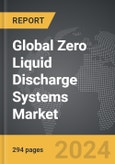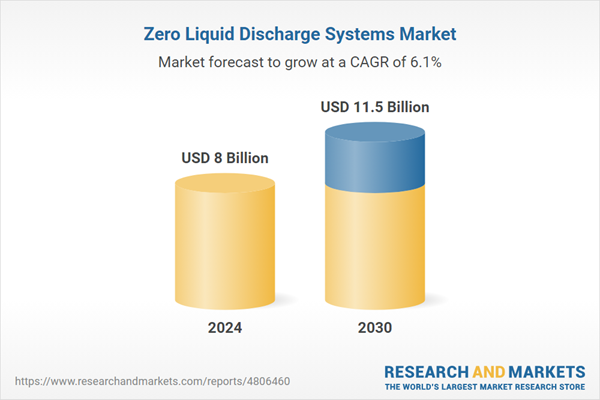Global Zero Liquid Discharge Systems Market - Key Trends & Drivers Summarized
Why Are Zero Liquid Discharge Systems Gaining Importance in Industrial Waste Management?
Zero liquid discharge (ZLD) systems are gaining significant importance in industrial waste management due to their ability to eliminate liquid waste and ensure water reuse and recycling. With increasing environmental regulations and the rising costs associated with wastewater disposal, industries such as power generation, chemical manufacturing, and pharmaceuticals are increasingly adopting ZLD systems to comply with environmental standards and reduce operational costs. These systems, which involve processes such as evaporation, crystallization, and reverse osmosis, help recover valuable resources from wastewater, supporting sustainability and cost-efficiency. The growing focus on water conservation and the need to address water scarcity issues are also driving the adoption of ZLD systems across various sectors.How Are Technological Advancements Enhancing Zero Liquid Discharge Systems?
Technological advancements are playing a crucial role in enhancing the efficiency and effectiveness of zero liquid discharge systems. Innovations in membrane technologies, such as advanced reverse osmosis and forward osmosis, are improving the recovery rates and reducing the energy consumption of ZLD systems. Additionally, the integration of automation and control systems is enabling real-time monitoring and optimization of ZLD processes, ensuring higher efficiency and reliability. The development of hybrid ZLD systems, which combine multiple treatment technologies, is also gaining traction as it offers better performance and cost-effectiveness. These technological advancements are making ZLD systems more viable and attractive for a wider range of industrial applications.What Challenges and Opportunities Exist in the Zero Liquid Discharge Systems Market?
The zero liquid discharge systems market faces several challenges and opportunities that impact its growth prospects. High capital and operational costs associated with ZLD systems are major challenges, particularly for small and medium-sized enterprises. Additionally, the complexity of ZLD processes and the need for skilled personnel to operate and maintain these systems can limit market adoption. However, there are significant opportunities for growth, driven by the increasing demand for sustainable water management solutions, stringent environmental regulations, and the rising awareness about the benefits of water reuse and recycling. The expansion of industries in emerging markets and the growing focus on corporate social responsibility are also contributing to the market's growth potential.The Growth in the Zero Liquid Discharge Systems Market Is Driven by Several Factors
The growth in the zero liquid discharge systems market is driven by several factors, including increasing environmental regulations, advancements in water treatment technologies, and the growing need for sustainable water management solutions. The rising focus on water conservation and the need to address water scarcity issues are major drivers, as ZLD systems enable water reuse and minimize waste disposal. Technological advancements, such as the development of advanced membrane technologies and automation systems, are enhancing the efficiency and cost-effectiveness of ZLD systems. Additionally, the expansion of industries in emerging economies, coupled with government initiatives promoting sustainable practices, is boosting the demand for ZLD systems. The growing emphasis on environmental sustainability and the adoption of circular economy principles are also contributing to the market's growth.Report Scope
The report analyzes the Zero Liquid Discharge Systems market, presented in terms of market value (US$ Thousand). The analysis covers the key segments and geographic regions outlined below.- Segments: Type (Conventional, Hybrid); Process (Evaporation & Crystallization, Filtration, Pretreatment); End-Use (Energy & Power, Chemicals & Petrochemicals, Food & Beverage, Pharmaceutical, Semiconductors & Electronics, Textiles, Other End-Uses).
- Geographic Regions/Countries:World; United States; Canada; Japan; China; Europe (France; Germany; Italy; United Kingdom; Spain; Russia; and Rest of Europe); Asia-Pacific (Australia; India; South Korea; and Rest of Asia-Pacific); Latin America (Argentina; Brazil; Mexico; and Rest of Latin America); Middle East (Iran; Israel; Saudi Arabia; United Arab Emirates; and Rest of Middle East); and Africa.
Key Insights:
- Market Growth: Understand the significant growth trajectory of the Conventional Systems segment, which is expected to reach US$8.1 Billion by 2030 with a CAGR of a 6.4%. The Hybrid Systems segment is also set to grow at 5.4% CAGR over the analysis period.
- Regional Analysis: Gain insights into the U.S. market, valued at $2.1 Billion in 2024, and China, forecasted to grow at an impressive 10.3% CAGR to reach $2.8 Billion by 2030. Discover growth trends in other key regions, including Japan, Canada, Germany, and the Asia-Pacific.
Why You Should Buy This Report:
- Detailed Market Analysis: Access a thorough analysis of the Global Zero Liquid Discharge Systems Market, covering all major geographic regions and market segments.
- Competitive Insights: Get an overview of the competitive landscape, including the market presence of major players across different geographies.
- Future Trends and Drivers: Understand the key trends and drivers shaping the future of the Global Zero Liquid Discharge Systems Market.
- Actionable Insights: Benefit from actionable insights that can help you identify new revenue opportunities and make strategic business decisions.
Key Questions Answered:
- How is the Global Zero Liquid Discharge Systems Market expected to evolve by 2030?
- What are the main drivers and restraints affecting the market?
- Which market segments will grow the most over the forecast period?
- How will market shares for different regions and segments change by 2030?
- Who are the leading players in the market, and what are their prospects?
Report Features:
- Comprehensive Market Data: Independent analysis of annual sales and market forecasts in US$ Million from 2024 to 2030.
- In-Depth Regional Analysis: Detailed insights into key markets, including the U.S., China, Japan, Canada, Europe, Asia-Pacific, Latin America, Middle East, and Africa.
- Company Profiles: Coverage of players such as Aquarion AG, Aquatech International LLC, GE Water & Process Technologies, GEA Group AG, H2O Gesellschaft mit beschrankter Haftung and more.
- Complimentary Updates: Receive free report updates for one year to keep you informed of the latest market developments.
Some of the 42 companies featured in this Zero Liquid Discharge Systems market report include:
- Aquarion AG
- Aquatech International LLC
- GE Water & Process Technologies
- GEA Group AG
- H2O Gesellschaft mit beschrankter Haftung
- Petro Sep Corporation
- Praj Industries Ltd.
- Safbon Water Technology
- Saltworks Technologies Inc.
- U.S. Water Services
- Veolia Water Technologies
This edition integrates the latest global trade and economic shifts into comprehensive market analysis. Key updates include:
- Tariff and Trade Impact: Insights into global tariff negotiations across 180+ countries, with analysis of supply chain turbulence, sourcing disruptions, and geographic realignment. Special focus on 2025 as a pivotal year for trade tensions, including updated perspectives on the Trump-era tariffs.
- Adjusted Forecasts and Analytics: Revised global and regional market forecasts through 2030, incorporating tariff effects, economic uncertainty, and structural changes in globalization. Includes historical analysis from 2015 to 2023.
- Strategic Market Dynamics: Evaluation of revised market prospects, regional outlooks, and key economic indicators such as population and urbanization trends.
- Innovation & Technology Trends: Latest developments in product and process innovation, emerging technologies, and key industry drivers shaping the competitive landscape.
- Competitive Intelligence: Updated global market share estimates for 2025, competitive positioning of major players (Strong/Active/Niche/Trivial), and refined focus on leading global brands and core players.
- Expert Insight & Commentary: Strategic analysis from economists, trade experts, and domain specialists to contextualize market shifts and identify emerging opportunities.
Table of Contents
Companies Mentioned (Partial List)
A selection of companies mentioned in this report includes, but is not limited to:
- Aquarion AG
- Aquatech International LLC
- GE Water & Process Technologies
- GEA Group AG
- H2O Gesellschaft mit beschrankter Haftung
- Petro Sep Corporation
- Praj Industries Ltd.
- Safbon Water Technology
- Saltworks Technologies Inc.
- U.S. Water Services
- Veolia Water Technologies
Table Information
| Report Attribute | Details |
|---|---|
| No. of Pages | 294 |
| Published | December 2025 |
| Forecast Period | 2024 - 2030 |
| Estimated Market Value ( USD | $ 8 Billion |
| Forecasted Market Value ( USD | $ 11.5 Billion |
| Compound Annual Growth Rate | 6.1% |
| Regions Covered | Global |









